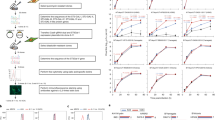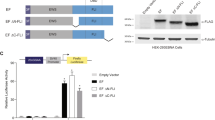Abstract
TODARO et al.1 have reported that transformation of established cell lines by murine (Kirsten, Molony) and feline sarcoma viruses resulted in the loss of receptors for the polypeptide mitogen epidermal growth factor (EGF). The phenomenon showed several forms of specificity; (1) transformation by other viruses such as avian arcoma viruses, polyoma virus or SV40 did not lead to the loss of EGF receptors, (2) transformation by Kirsten murine sarcoma virus did not lead to the loss of cellular receptors for another mitogenic peptide known as multiplication stimulating activity (MSA)2, and (3) in a related observation, human fibrosarcoma cell lines had high levels of EGF receptors but low levels of MSA receptors2. From these observations Todaro et al.2 formulated the following hypothesis: “Cell growth in an organism is controlled in part by the particular display of specific growth factor receptors responding to hormones produced by other cells. In the normal situation those cells that produce a specific growth factor do not respond to it. But the inappropriate production by a target cell of an active hormone, that it also has receptors for, may be sufficient to serve as a stimulus for cell division. Persistent uncontrolled production of the growth factor may then serve as a continuous endogenous stimulus and lead to inappropriate cell growth.” As one alternative, this group has suggested that transformation by murine sarcoma virus might lead to “the production of endogenous EGF or a related substance that binds to EGF receptors”1; and have in fact suggested that “the sarcoma genes code for an EGF related substance”1. This model suggests that the phenotypic expression of viral transformation can be broken at two possible points. If the sarcoma gene product is altered to such a degree that it is unable to bind to the appropriate mitogen receptor, the cell will remain untransformed. Alternatively, untransformed cell lines lacking specific mitogen receptors should not show phenotypic transformation (that is, focus formation) when exposed to the appropriate virus, as the sarcoma gene product produced as a consequence of the transformation event will be unable to stimulate cell division if the appropriate receptor is absent. We have recently isolated and characterised variant Swiss 3T3 cell lines which grow to low cell densities, do not show a mitogenic response to added EGF, do not bind labelled EGF, even at concentrations of hormone 10-fold greater than required for receptor saturation by the parent cell line, and respond to a variety of other mitogens3. According to the model proposed by Todaro et al.1 transformation of these cells by a murine sarcoma virus should not lead to the characteristic alteration in cell density, as the EGF receptor postulated to be ‘responsive’ to the murine sarcoma gene product is not present. Our studies, however, suggest these EGF receptorless variants are as susceptible to transformation by Kirsten sarcoma virus as the parent 3T3 line.
This is a preview of subscription content, access via your institution
Access options
Subscribe to this journal
Receive 51 print issues and online access
$199.00 per year
only $3.90 per issue
Buy this article
- Purchase on Springer Link
- Instant access to full article PDF
Prices may be subject to local taxes which are calculated during checkout
Similar content being viewed by others
References
Todaro, G. J., De Larco, J. E. & Cohen, S. Nature 264, 26–31 (1976).
Todaro, G. J., De Larco, J. E., Nissley, S. P. & Rechler, M. M. Nature 267, 526–528 (1977).
Pruss, R. M. & Herschman, H. R. Proc. natn. Acad. Sci. U.S.A. 74, 3918–3921 (1977).
Roy-Burman, P. & Clement, V. J. gen. Virol. 28, 193–198 (1975).
Goldfine, I. D. & Smith, G. J. Proc. natn. Acad. Sci. U.S.A. 73, 1427–1431 (1976).
Andres, R. Y., Jeng, I. & Bradshaw, R. A. Proc. natn. Acad. Sci. U.S.A. 74, 2785–2789 (1977).
Savage, C. R. & Cohen, S. J. biol. Chem. 247, 7609–7611 (1972).
Author information
Authors and Affiliations
Rights and permissions
About this article
Cite this article
PRUSS, R., HERSCHMAN, H. & KLEMENT, V. 3T3 variants lacking receptors for epidermal growth factor are susceptible to transformation by Kirsten sarcoma virus. Nature 274, 272–274 (1978). https://doi.org/10.1038/274272a0
Received:
Accepted:
Published:
Issue Date:
DOI: https://doi.org/10.1038/274272a0
Comments
By submitting a comment you agree to abide by our Terms and Community Guidelines. If you find something abusive or that does not comply with our terms or guidelines please flag it as inappropriate.



